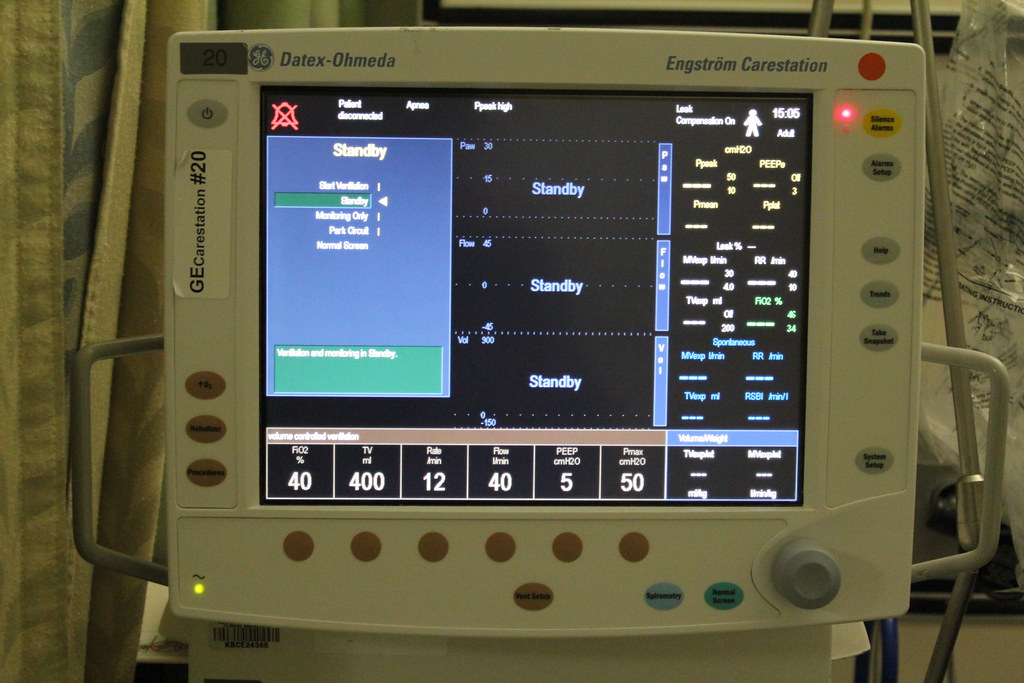2.10 Settings and Definitions
Control modes
The most important thing to remember is that control modes are designed to completely replace the physiological process of breathing. Every aspect of the breath must be set and “controlled” by the clinician. Every single breath that is delivered by the ventilator, whether initiated by the ventilator or triggered by the patient, is exactly the same and depends completely on the parameters set.

So, what do you need to set when working with a control mode? With any mode of ventilation, you always set the following two settings:
- the level of PEEP to keep the alveoli from collapsing
- the amount of FiO2 to adequately oxygenate your patient
In addition to these mandatory settings for all modes of ventilation, in control modes you also have to set three parameters:
- How often the patient will breathe
- How big a breath the patient will get
- How fast the air will be given to the person
How often breaths will be delivered is usually expressed by a Respiratory Rate ([latex]RR[/latex]). This is the minimum number of breaths that is delivered over the course of one minute. Patients can trigger breaths above this rate, and these additional breaths will be reflected in the Total RR.
How big a breath the patient will get is usually expressed by the volume of air that is pushed into the lungs. The term for this is Tidal Volume ([latex]V_T[/latex]), which refers to the volume of air in mLs that is given every time a breath is delivered. The volume of air delivered can be altered depending on whether the mode is a volume or pressure control, via describing the volume itself or the pressure applied to the lungs (expressed as the Pressure Control or [latex]PC[/latex]). You will learn this concept in detail in Chapter 4.
Modes will also allow you to change how long the breath of air takes to be given. Changing the length of a breath is accomplished by changing the speed by which the air is pushed in by the ventilator. Volume and Pressure Control modes allow you to adjust the speed of air being delivered by either adjusting the Flow Rate ([latex]\dot V[/latex]) or the time the air is delivered (referred to as Inspiratory Time or [latex]I_T[/latex]). You can learn all about these settings in Chapter 4.
In summary, you know you are in a control mode when the following three parameters are set:
- A Respiratory Rate
- A Volume or Pressure applied by the ventilator
- The Flowrate or Time the air is being pushed into the lungs
Key Takeaway
Spontaneous modes
Like control modes, spontaneous modes of ventilation are also delivered via positive pressure application from a mechanical ventilator. The same mandatory settings must be set, including:
- the level of PEEP to keep the alveoli from collapsing
- the amount of FiO2 to adequately oxygenate your patient
But, unlike control breaths, in spontaneous modes, the patient initiates their own breath and is responsible for deciding how many breaths to take and how often they want to breathe. You do not decide the set volume or rate that the patient will breathe. Here, you only decide how much “extra help” the ventilator will give to facilitate the breath the patient is taking in. The main setting that matters here is:
- How much support we want to give to the patient
When the patient initiates a breath via their physiological trigger and a contracting diaphragm, the ventilator senses this contraction and “helps” the patient pull in air by pushing a little while the patient pulls the air in. This support lightens the respiration workload the patient has to do.
Object Lesson
Imagine you’re a child outside playing on a hot summer day. You spot a garden hose nearby and decide to take a drink. Although the hose is turned off, there is cold water in the hose line. You create suction and try to pull in the water. You need to work to get the water you need. If someone were to turn on the hose, this would help you get water easier. If the water was only turned on as a “trickle”, you might want more water than that and still use suction to pull more from the hose. If the hose was turned on higher, you could easily take all the water you want with no “work” from sucking on the hose.

In summary, you know you are in a spontaneous mode by what is not set. There is no set respiratory rate or set volume or flow rate. You only set a pressure to help augment the breath.
"Settings and Definitions" from Basic Principles of Mechanical Ventilation by Melody Bishop, © Sault College is licensed under a Creative Commons Attribution-NonCommercial-ShareAlike 4.0 International License, except where otherwise noted.

